Choosing the right API monitoring tool is about more than just uptime checks — it’s about gaining full visibility into how your APIs perform under real-world conditions.
In this guide, we’ll break down the best API monitoring tools, including powerful open-source options. Whether you're debugging latency, tracking error spikes, or ensuring your third-party APIs don’t go silent, these tools help you stay in control.
But before diving into the list, let’s briefly cover the key metrics you should be monitoring.
Key API Metrics to Monitor
To catch issues early and maintain high performance, you need to monitor:
- Uptime – Is your API reachable and responding as expected?
- Latency – How fast is your API responding? High latency often points to performance bottlenecks.
- Requests Per Minute (RPM) – Helps track traffic trends and understand load patterns.
- Errors Per Minute – A rising error rate can be the first sign of a failing deployment or broken dependency.
- CPU & Memory Usage – Track resource consumption to prevent overloads and optimize infrastructure.
- Time To First Hello World (TTFHW) – Measures how long it takes a new user to make their first successful API call — useful for developer experience benchmarking.
These metrics form the backbone of any solid monitoring setup — and the tools we’ll cover make it easy to collect, visualize, and alert on them.
Top API Monitoring Tools for Developers
Here’s a curated list of API monitoring tools — a mix of open-source and commercial — grouped by what they do best:
🧪 Open Source API Monitoring Tools
- SigNoz – Open-source alternative to Datadog. Built for developers who want full-stack observability (logs, metrics, traces) with support for OpenTelemetry.
- Prometheus – Time-series monitoring system with a strong ecosystem. Great for metrics-heavy API monitoring.
- Graphite – Another open-source monitoring tool, best for visualizing time-series data, though it requires external components for alerts.
🔍 Full-Stack Observability & APM
These tools go beyond APIs — they offer logs, traces, and infrastructure monitoring.
- Datadog – Cloud-native observability with 500+ integrations. Strong dashboards, alerts, and tracing support.
- New Relic – End-to-end visibility with APM, browser monitoring, and ML-powered insights.
- AppDynamics – Enterprise-focused with a business lens on performance.
- Atatus – Lightweight observability platform for modern applications.
📊 API-Focused Monitoring & Analytics
Best if your primary concern is API traffic, SLAs, and user behavior.
- Moesif – API analytics and debugging focused on developer experience and product insights.
- APIMetrics – Tracks SLAs and latency across regions with real-world monitoring.
- Assertible – Simplifies API testing and integrates into CI/CD pipelines for automated health checks.
🧪 Synthetic & Functional API Testing
Useful when you need scheduled tests and pre-production validation.
- Postman – Popular API platform with built-in monitors for uptime and response checks.
- SmartBear (AlertSite) – Advanced synthetic monitoring with robust reporting.
☁️ Infra & Ecosystem-Native Tools
For teams heavily invested in cloud-native stacks.
- AWS CloudWatch – AWS-native monitoring with custom metrics and logs for API Gateway, Lambda, etc.
- Sematext – Full-stack observability for modern cloud-native apps.
- RapidAPI – Ideal for public and internal API marketplaces with analytics, testing, and collaboration.
SigNoz
Open-source alternative to Datadog built for developers. It provides unified observability with logs, metrics, and traces, and natively supports OpenTelemetry, making it a great choice for API monitoring.
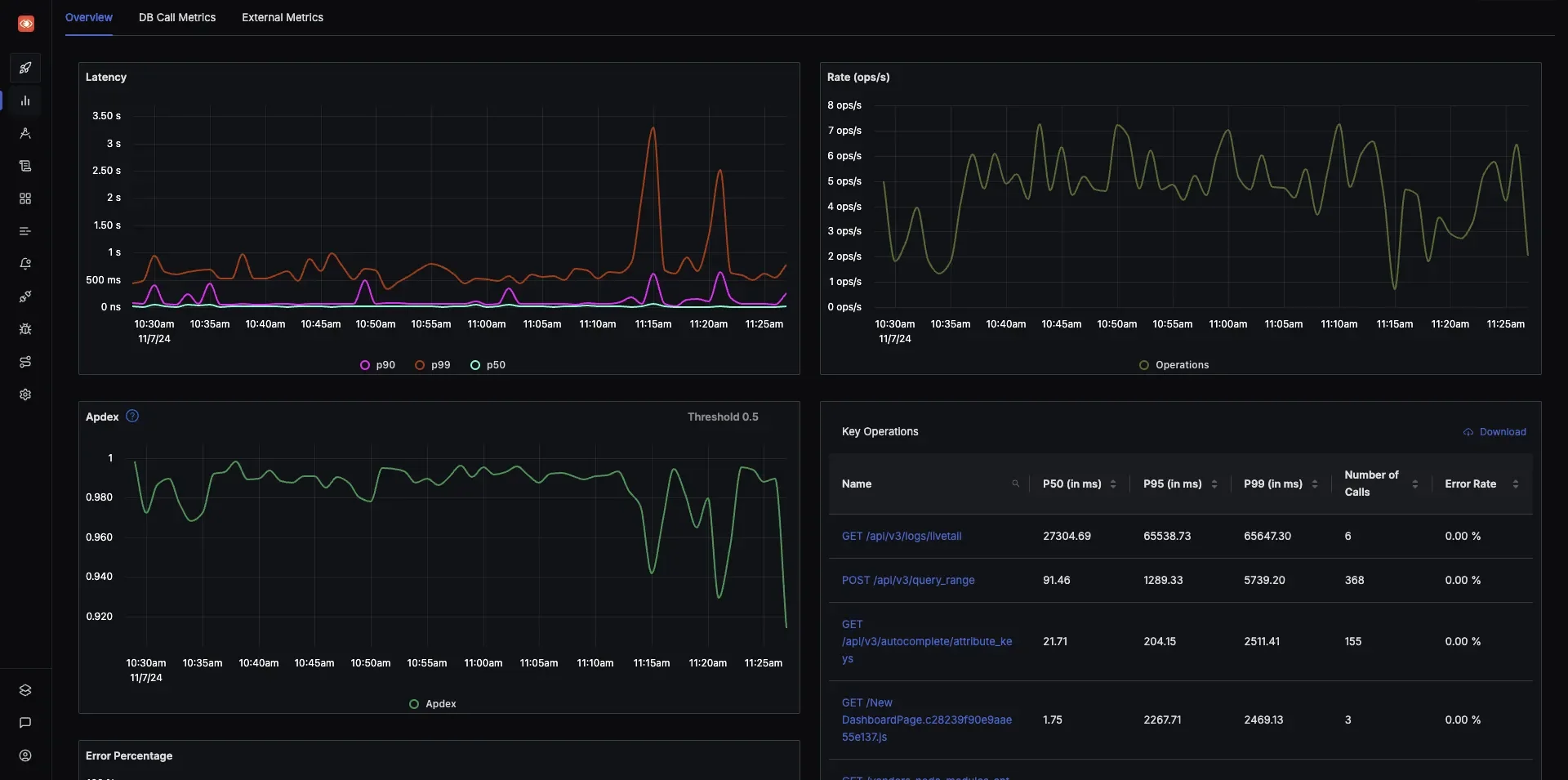
Pros
- Unified observability (logs + metrics + traces), ideal for full-stack API monitoring
- OpenTelemetry-native — automatic instrumentation for APIs
- Self-hostable, giving you control over your API telemetry
- Real-time monitoring and alerting of API performance metrics like latency, request rates, and error rates
Cons
- Initial setup can be heavier compared to fully managed tools
Pricing
- Free and open-source
- Cloud plans available, usage-based
- Gotcha: Cloud costs may increase if you don’t manage telemetry volume effectively
Best for
Teams looking for an open-source API monitoring solution with full-stack observability and OpenTelemetry support.
Check out API Monitoring in SigNoz.
SigNoz Cloud is the easiest way to run SigNoz. Sign up for a free account and get 30 days of unlimited access to all features.
You can also install and self-host SigNoz yourself since it is open-source. With 24,000+ GitHub stars, open-source SigNoz is loved by developers. Find the instructions to self-host SigNoz.
Prometheus
An open-source monitoring system designed for collecting and querying time-series data, often used with Grafana for visualizing API metrics.
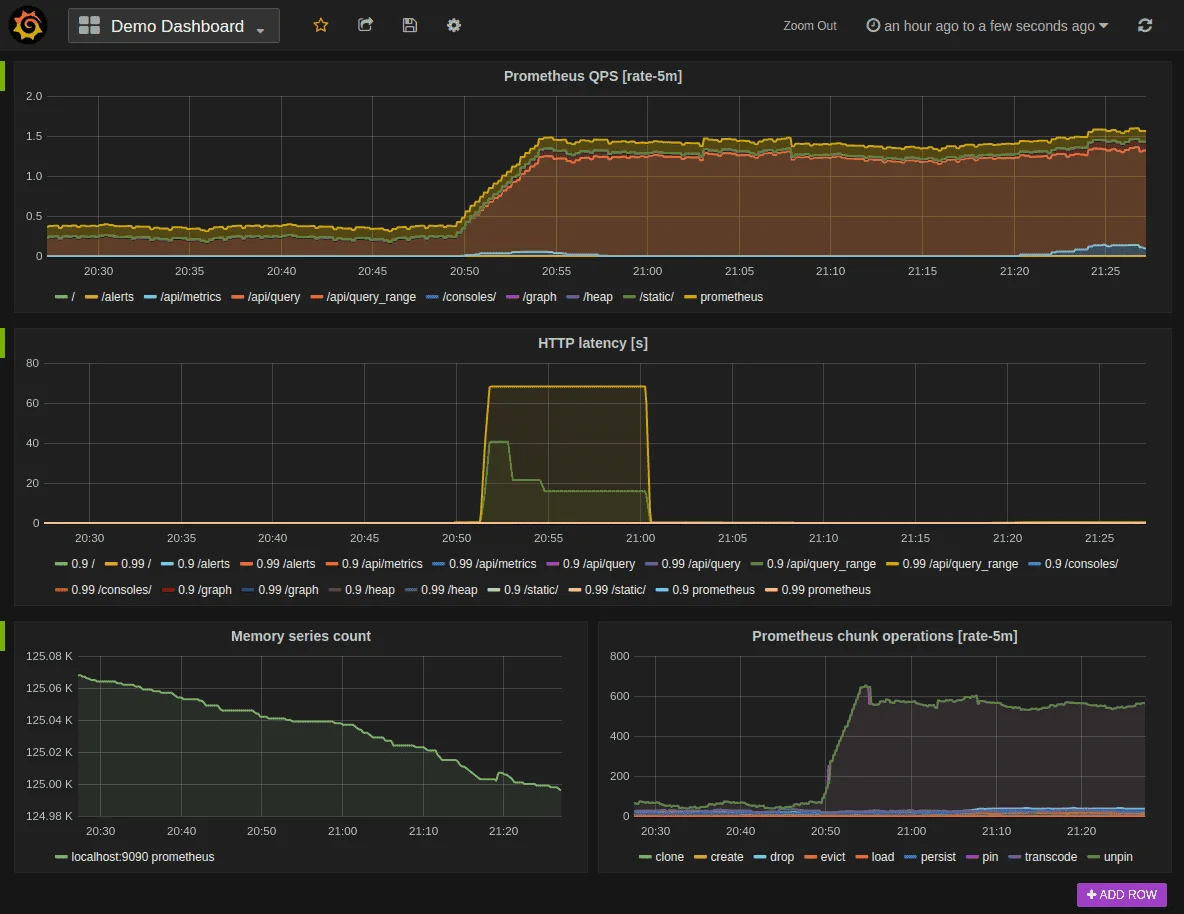
Pros
- Great for collecting API metrics like request rates, latencies, and error rates
- Excellent for time-series data, ideal for monitoring API performance over time
- Works well with exporters and custom metrics, so you can easily integrate API monitoring
- Rich querying capabilities with PromQL
Cons
- Doesn’t offer native support for logs or traces—needs additional tools like Loki and Jaeger
- Setup and scaling can be challenging without experienced engineers
Pricing
- Free and open-source
- Gotcha: Prometheus alone doesn’t provide a complete API monitoring solution; you’ll need to integrate it with other tools (Grafana, Loki, Jaeger)
Best for
Teams already using Prometheus or who want deep, customizable metrics for monitoring API performance over time.
Graphite
Open-source metrics collection and visualization tool focused on time-series data. Works best when you just want to track API metrics like request rates or error counts.
Pros
- Great for tracking custom API metrics
- Integrates well with tools like StatsD and collectd for collecting API metrics
- Lightweight and script-friendly
Cons
- No native support for logs or traces
- Doesn’t offer any out-of-the-box API monitoring features (like request inspection or error tracking)
- Needs external components for alerts and dashboards
Pricing
- Free and open-source
- Gotcha: You’ll likely need to pair it with Grafana or another visualization layer
Best for
Teams building a DIY metrics pipeline for API performance (e.g., latency, error rates).
Datadog
Cloud-based observability platform offering full-stack monitoring, including API monitoring with APM, distributed tracing, and log management.
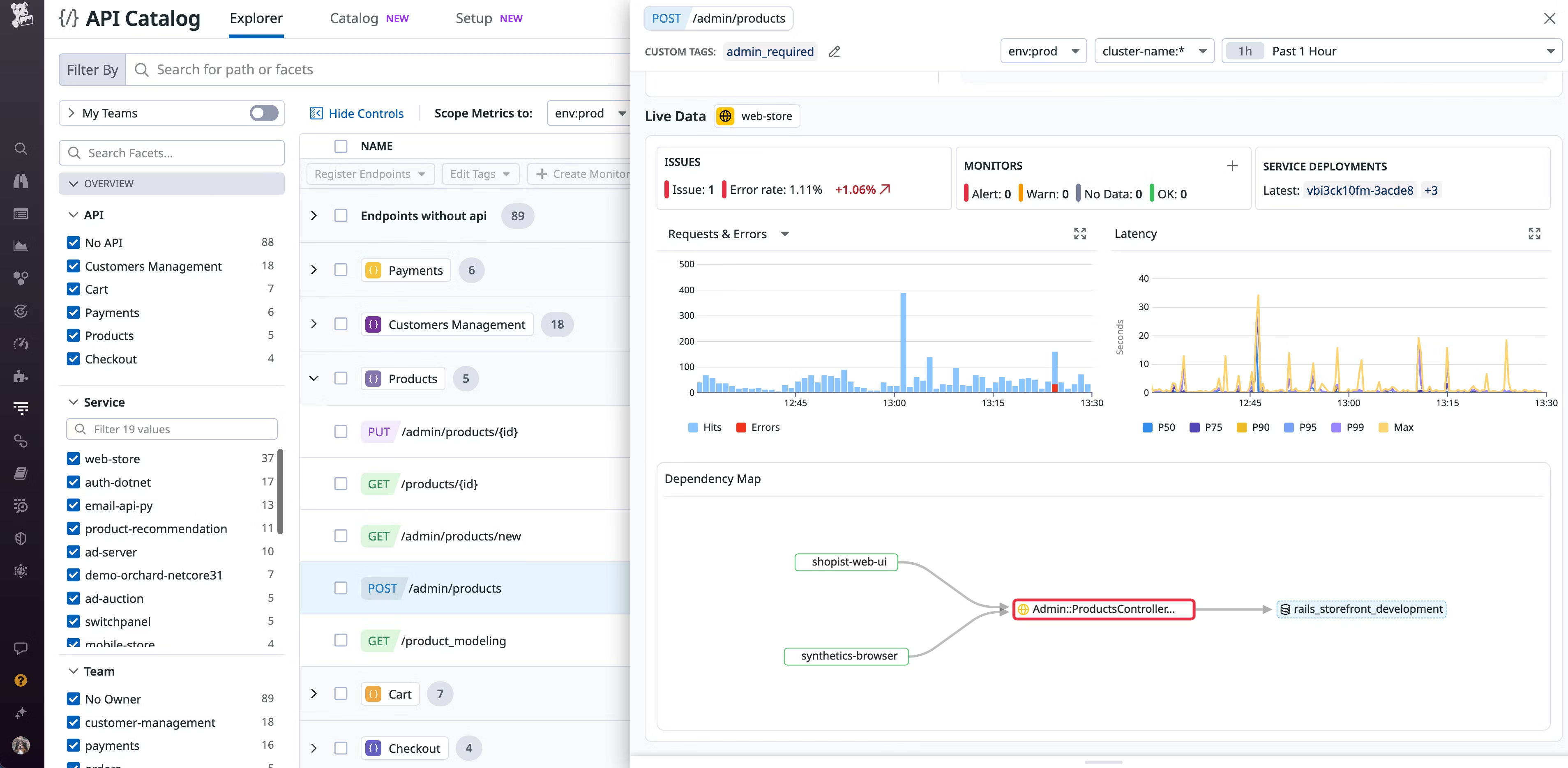
Pros
- Easy integration for monitoring APIs with automatic instrumentation
- Real-time monitoring of API requests, response times, and error rates
- Built-in distributed tracing to track API calls across services
- Advanced alerting, anomaly detection, and root cause analysis
Cons
- Pricing can become expensive, especially if you're only using it for API monitoring
- Some advanced features are only available in higher-tier plans
- UI can be overwhelming for teams who only need API-focused metrics
Pricing
- Usage-based pricing (by data volume, integrations, and users)
- Free tier available with limited features
- Gotcha: Pricing can scale quickly depending on the amount of data ingested (API request volume)
Best for
Teams that want a fully managed, scalable solution for API monitoring with minimal setup and advanced capabilities like distributed tracing and anomaly detection.
New Relic
Full-stack observability platform with solid support for API monitoring out of the box—APM, distributed tracing, and alerting included.

Pros
- Automatic instrumentation of popular web frameworks (great for APIs)
- Monitor API response times, errors, throughput, and SLAs easily
- Distributed tracing for debugging slow or failing API calls
Cons
- UI can feel cluttered for simple API use cases
- Can be pricey if you're only monitoring APIs
Pricing
- Free tier: 100 GB/month of telemetry
- Usage-based pricing afterward
- Gotcha: No hard limit alert—surprise bills if you exceed quotas
Best for
Teams who want quick visibility into API health with minimal manual setup.
SmartBear (AlertSite)
An advanced synthetic monitoring solution with a strong focus on API uptime, performance, and robust reporting, designed for production API environments.

Pros
- Offers synthetic monitoring for API uptime, availability, and response time
- Detailed reporting on API performance with SLA compliance tracking
- Excellent for monitoring critical APIs in production with geographical testing capabilities
- Powerful integration options for team collaboration and alerting on performance issues
Cons
- Focuses heavily on synthetic monitoring, not offering real-time performance metrics from production traffic
- Can be more complex to set up for teams who only need simple API uptime checks
Pricing
- Paid plans start at $99/month, with pricing based on the number of tests and frequency of checks
- Gotcha: Costs can increase with more frequent checks or a larger number of monitored APIs
Best for
Teams requiring advanced synthetic API monitoring with SLA tracking and detailed performance reports, especially for APIs in critical production environments.
Moesif
API analytics and monitoring platform built specifically for API-centric teams. Provides deep insights into API usage patterns, performance, and errors.

Pros
- Provides API-centric monitoring with detailed insights into API traffic, latency, and errors
- Granular tracking of API performance by user, endpoint, or request type
- Supports real-time alerting and anomaly detection for API issues
- Easy-to-use dashboards and analytics tailored to API monitoring
Cons
- Focused primarily on API usage and performance—less comprehensive for full-stack observability
- Limited integrations compared to larger, more general-purpose tools
Pricing
- Free plan available with limited API calls
- Paid plans start at ~$79/month for full-feature access
- Gotcha: Paid plans are based on API call volume, so pricing may increase if you scale usage quickly
Best for
Teams that are focused on deep API performance and usage analytics, and need specialized API monitoring features.
AppDynamics
Enterprise-grade APM tool with strong capabilities for monitoring APIs in large, distributed systems.
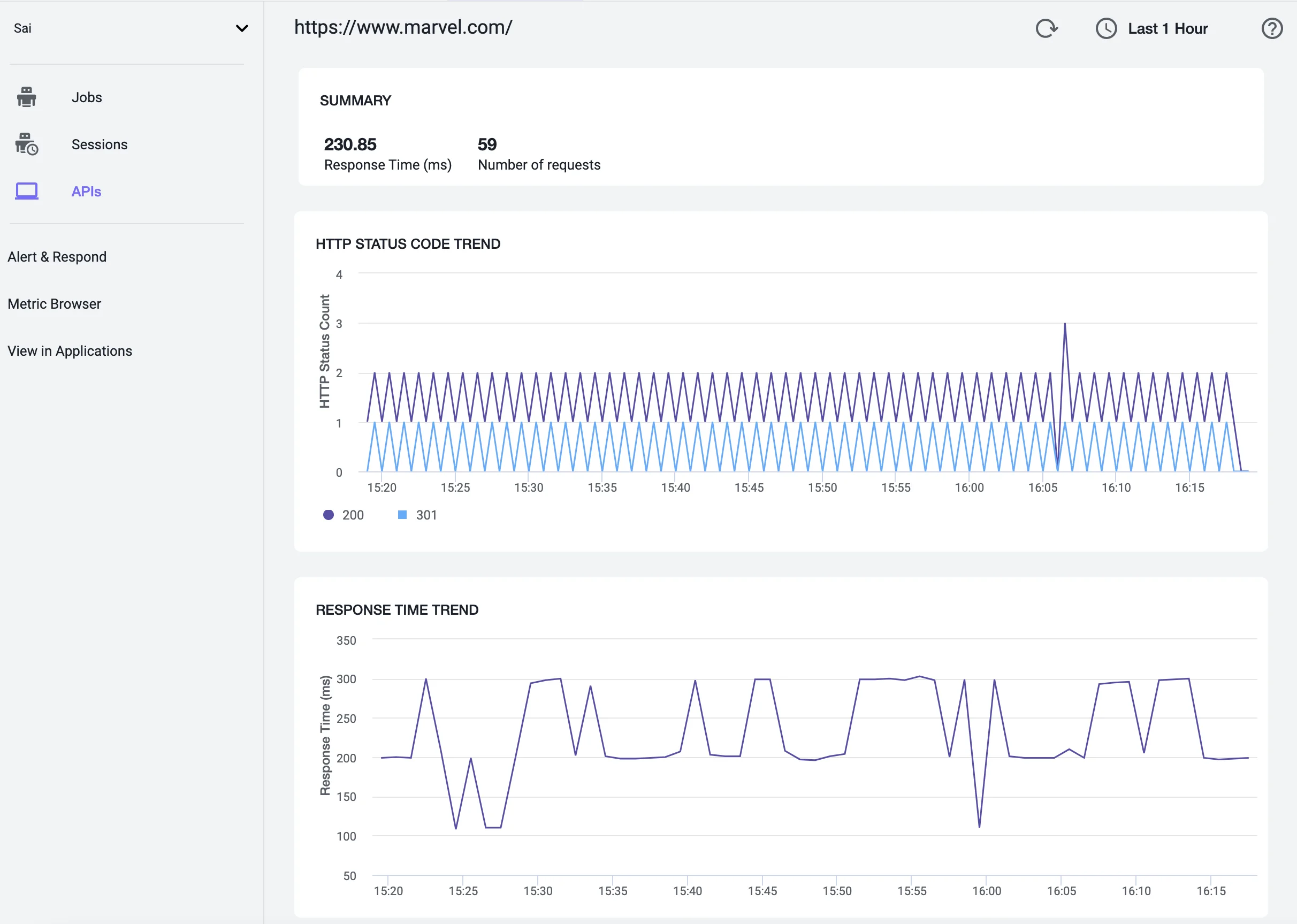
Pros
- Transaction snapshots for APIs help with root cause analysis
- Monitors business KPIs tied to API endpoints
- Provides SLA monitoring, baselines, and anomaly detection
Cons
- Can be overkill for just API monitoring
- Complex configuration and onboarding
- Focuses more on enterprise apps than dev-first workflows
Pricing
- Tiered enterprise pricing
- Gotcha: Price may not justify if you're only focused on API monitoring
Best for
Enterprises looking to tie API performance to business metrics and SLAs.
Sematext
A full-stack observability platform that provides monitoring for cloud-native applications, focusing on logs, metrics, and traces for modern APIs.

Pros
- Unified observability for logs, metrics, and traces, great for full-stack API monitoring
- Supports cloud-native applications and microservices architectures
- Offers real-time API monitoring with custom metrics and alerting
- Provides log management capabilities alongside API monitoring, useful for troubleshooting API failures
Cons
- More generalized observability tool, not focused exclusively on API monitoring
- Might require more configuration to specifically target API performance insights compared to dedicated API monitoring tools
- Can be overkill for teams who need simple API uptime monitoring
Pricing
- Free plan with basic features
- Paid plans starting at $75/month, scaling based on the number of monitored services and data volume
- Gotcha: Pricing increases with additional integrations and higher volumes of logs and metrics
Best for
Teams looking for an all-in-one solution that provides observability for modern cloud-native APIs, especially in microservices architectures, where multiple monitoring tools may be required.
RapidAPI
A platform designed for managing public and internal APIs, with advanced features for API analytics, testing, and collaboration within API marketplaces.
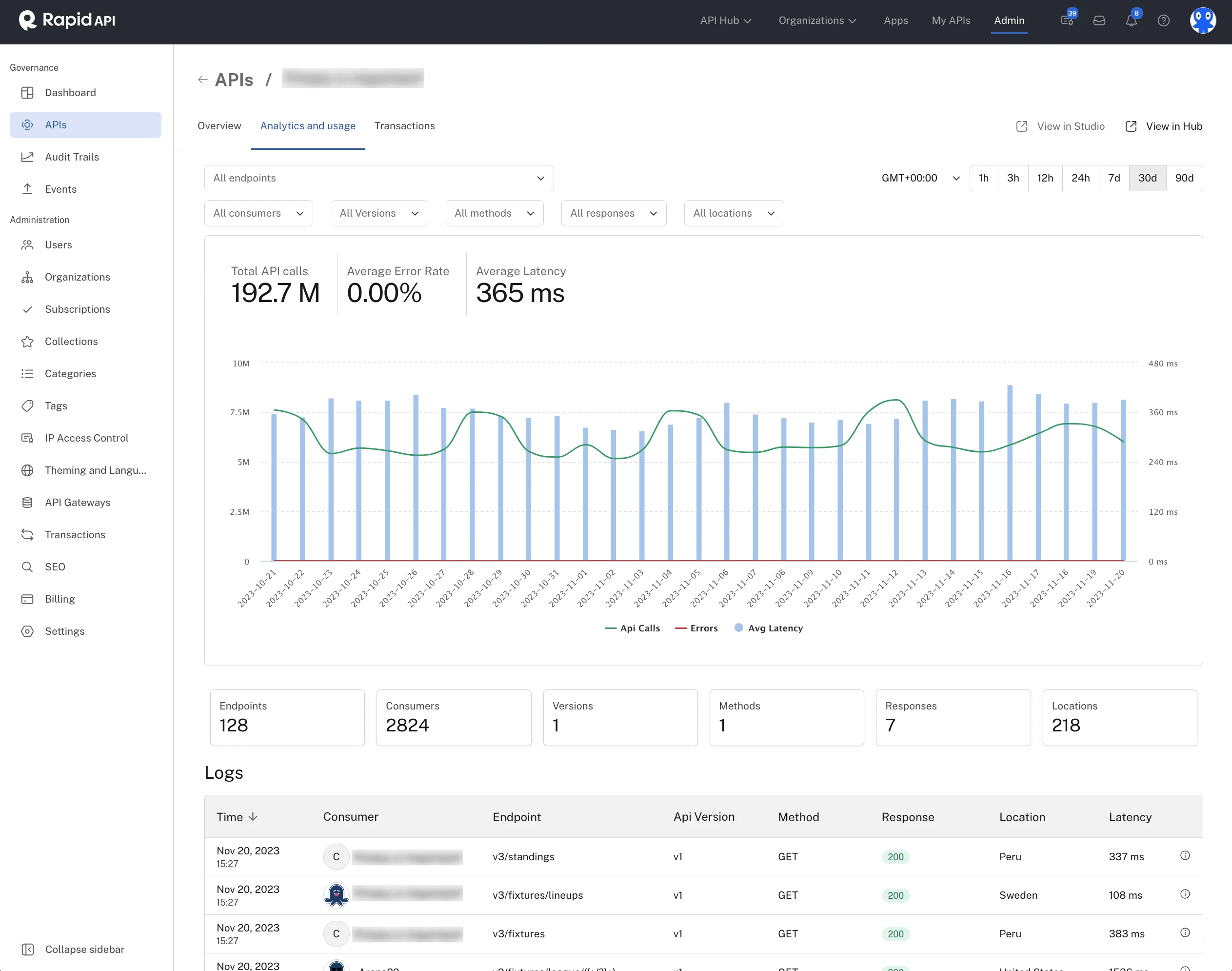
Pros
- Great for monitoring public and internal APIs with features like API analytics, uptime tracking, and testing
- Built-in tools for testing APIs before going live, with automated monitoring capabilities
- Supports collaboration between developers through API marketplaces, making it easy to share and distribute APIs
- Detailed insights into API usage and performance metrics, ideal for teams running API-driven businesses
Cons
- Primarily geared toward API providers rather than consumers or API monitoring from a backend perspective
- Doesn’t offer deep insights into internal server performance or traces, which are critical for debugging API issues
- Less suited for real-time monitoring or observability at scale compared to dedicated monitoring tools
Pricing
- Free tier available with basic API management and testing features
- Paid plans starting at $10/month, scaling based on the number of APIs and users
- Gotcha: Pricing is based on the number of API calls and marketplace usage, which can grow as your API usage expands
Best for
API-driven businesses and teams that need to manage both public and internal APIs, focusing on API testing, collaboration, and usage analytics in a marketplace environment.
AWS CloudWatch
An AWS-native monitoring tool designed to collect and track metrics, logs, and events for various AWS services, including API Gateway, Lambda, and EC2.

Pros
- Deep integration with AWS services, making it ideal for monitoring APIs hosted on AWS like API Gateway and Lambda
- Supports custom metrics and logs, allowing for tailored monitoring of API performance
- Offers detailed insights into AWS resource usage and API traffic in real-time
- Scalable and highly reliable, with native integration into the AWS ecosystem
Cons
- Limited to AWS services and doesn’t support easy integration with external APIs outside the AWS environment
- The interface can be overwhelming for teams not already embedded in AWS
- Doesn’t provide advanced features like synthetic API testing or SLA monitoring out of the box
Pricing
- Pay-as-you-go pricing based on the number of metrics and logs collected
- Gotcha: Costs can quickly escalate with high-volume API traffic and extensive logging
Best for
Teams using AWS for their infrastructure and looking for seamless API monitoring within the AWS ecosystem, especially for Lambda functions and API Gateway.
Postman
A widely-used platform for testing and monitoring APIs, with built-in monitors for uptime checks and response time tracking.

Pros
- Easy-to-use API platform with built-in monitors for uptime and response time checks
- Supports automated API testing and monitoring through collections
- Allows users to run tests on APIs at scheduled intervals for proactive issue detection
- Detailed insights into API performance with a focus on uptime and reliability
Cons
- More focused on testing rather than full-stack API monitoring with traces or logs
- Doesn’t provide deep performance metrics or real-time alerting features for production environments
Pricing
- Free tier with basic monitoring features
- Paid plans start at $12/month for more advanced functionality and additional monitors
- Gotcha: API monitoring features in Postman are limited compared to dedicated monitoring tools
Best for
Teams that need easy-to-setup API monitoring for basic uptime checks and response validations, especially during development or testing phases.
Assertible
An API testing and monitoring tool that focuses on simplifying API testing and integrates seamlessly into CI/CD pipelines for automated health checks.

Pros
- Simplifies API health checks with a focus on automation
- Integrates directly into CI/CD pipelines, ensuring APIs are tested continuously
- Provides detailed monitoring of API uptime, performance, and error rates
- Great for teams that need functional and smoke testing for their APIs before deployment
Cons
- Not as comprehensive as full observability tools for real-time monitoring of API traffic and logs
- Primarily designed for testing rather than post-deployment monitoring
Pricing
- Free tier available with basic features
- Paid plans start at $99/month, offering more integrations and testing features
- Gotcha: Pricing scales based on the number of tests and environments
Best for
Development teams looking to integrate functional API testing into their CI/CD workflows to ensure APIs are healthy and performant during development cycles.
APIMetrics
An API monitoring solution that tracks SLAs and latency across regions with real-world monitoring, providing teams with insights into how their APIs perform in production environments.
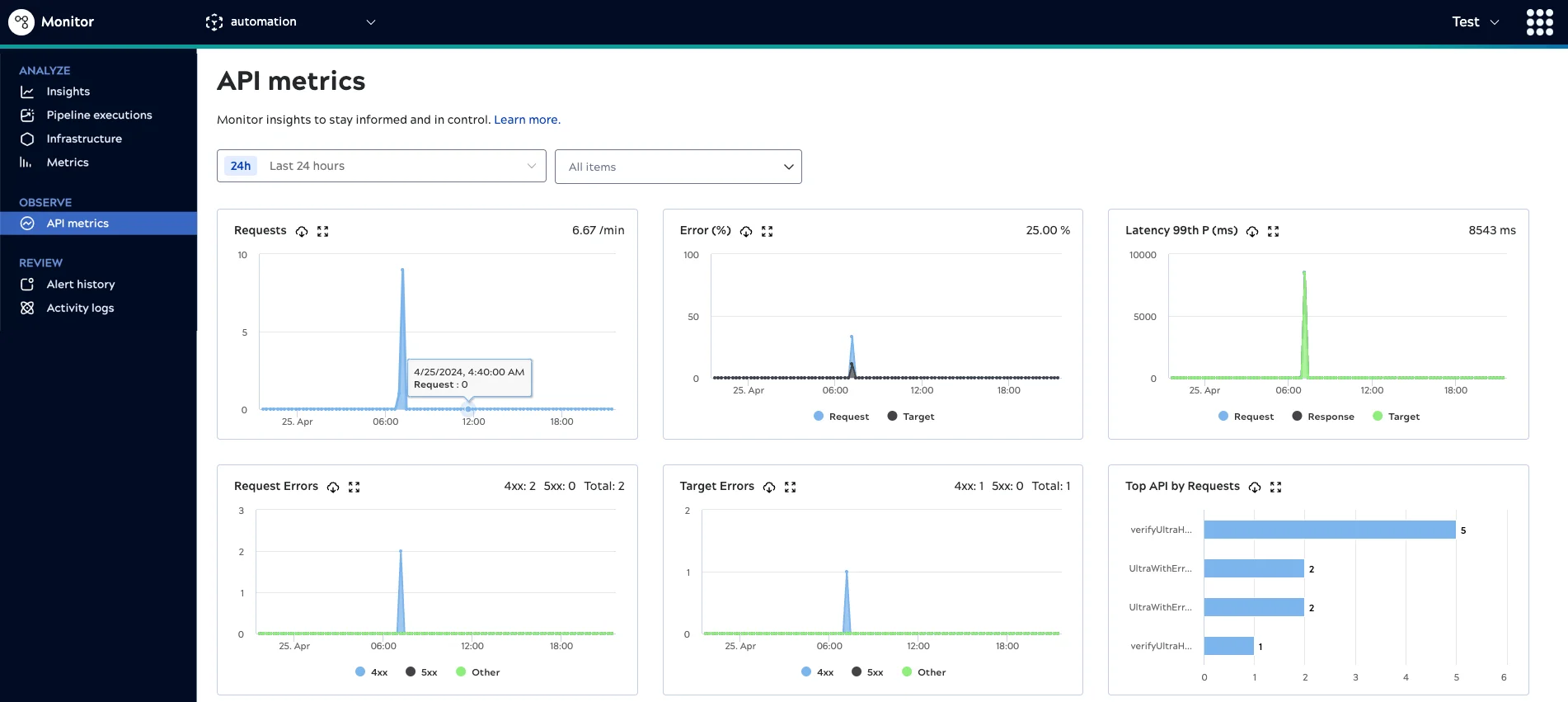
Pros
- Specialized in tracking SLAs (Service Level Agreements) and latency across multiple regions
- Real-world monitoring that accurately reflects user experience
- Helps monitor uptime and performance in diverse geographic locations
- Detailed reporting on API performance against SLAs, ideal for performance benchmarking
Cons
- More specialized than general monitoring solutions, may lack broader observability features
- Doesn’t provide deep insights into internal API performance metrics or logs
Pricing
- Paid plans with different tiers based on the number of monitored APIs and regions
- Gotcha: Pricing can grow as you monitor more regions and SLAs
Best for
Teams that need to monitor APIs across regions and ensure compliance with SLAs, particularly for customer-facing APIs with performance benchmarks.
Atatus
Lightweight observability platform that includes API monitoring through backend APM, logs, and alerts.
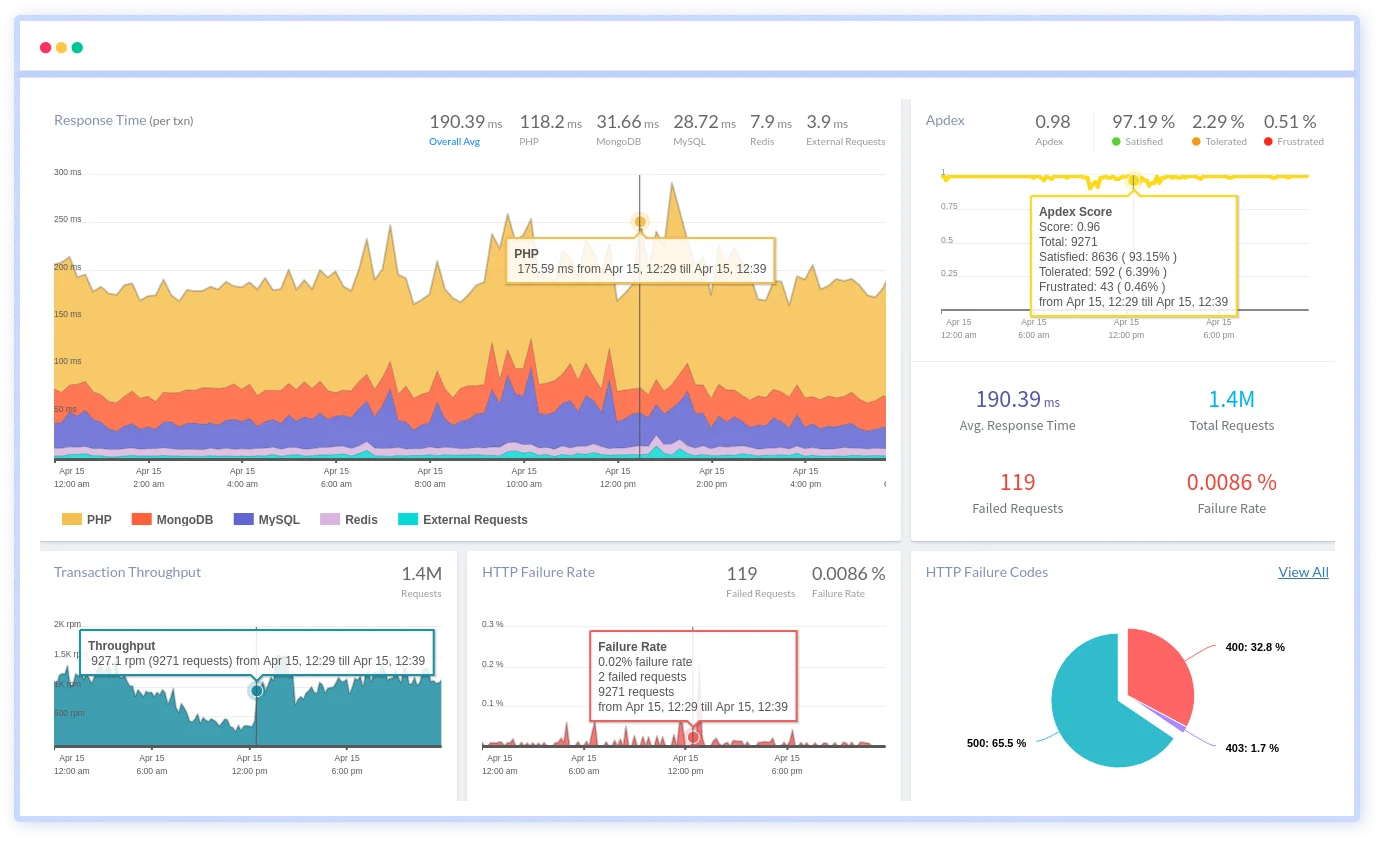
Pros
- Easy to monitor API response times, throughput, and error rates
- Real-time alerting on API failures
Cons
- Limited advanced features like distributed tracing
- Smaller community and integrations
Pricing
- Free plan available
- Paid plans from ~$39/month
- Gotcha: Some deeper monitoring (e.g., log correlations) require higher tiers
Best for
Small to mid-size teams looking for quick setup to track API performance, availability, and error rates.
What Should You Use?
As a developer, I understand you don’t want another bloated dashboard—you want answers when APIs break. The right API monitoring tool should:
- Catch issues before your users do
- Help you trace weird latency spikes or 500s down to the root
- Play nice with your stack (no forced agents or SDK lock-ins)
- Not cost you your SRE’s soul to configure
If you're building modern services, observability > ping checks.
Tools like SigNoz and Prometheus give you low-level visibility and full trace context. For production-grade monitoring that’s also OpenTelemetry-native, SigNoz hits that sweet spot—open source, dev-first, and purpose-built for debugging distributed systems.
Debug faster, monitor smarter, and don’t wait till users rage-tweet at you.
FAQs
What is API monitoring?
API monitoring is the process of continuously tracking and analyzing the performance, availability, and functionality of Application Programming Interfaces (APIs). It involves keeping a close eye on various metrics such as response times, error rates, and uptime to ensure that APIs are functioning optimally and meeting service level agreements (SLAs).
Why is API monitoring important?
API monitoring is crucial because:
- It helps maintain the reliability and performance of your services.
- It allows you to detect and resolve issues before they impact end-users.
- It provides insights for capacity planning and optimization.
- It ensures compliance with SLAs and helps maintain customer satisfaction.
- It aids in identifying security threats and potential vulnerabilities.
What are some key metrics to monitor for APIs?
Some essential metrics to monitor for APIs include:
- Response time (latency)
- Error rate
- Requests per minute (throughput)
- Uptime/availability
- CPU and memory usage
- Time to First Hello World (TTFHW)
- Errors per minute
How often should APIs be monitored?
APIs should be monitored continuously in real time. However, the frequency of detailed reports or alerts can vary based on your needs. Many organizations opt for:
- Real-time alerting for critical issues
- Hourly or daily summary reports for general performance
- Weekly or monthly in-depth analysis for trend identification and long-term planning
What's the difference between synthetic and real user monitoring for APIs?
- Synthetic monitoring simulates API calls at regular intervals from various locations to test availability and performance. It's proactive and helps identify issues before real users encounter them.
- Real user monitoring (RUM) captures actual user interactions with your APIs. It provides insights into real-world performance and user experience but is reactive as it detects issues after they occur.
